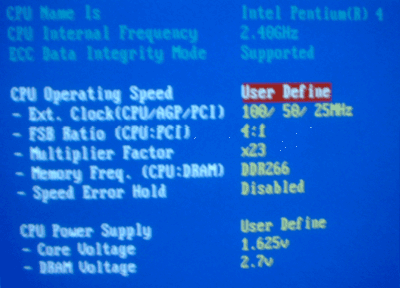|
Posted: April 6th, 2002
Written by: Tuan Huynh
[an error occurred while processing this directive]
BIOS

When it comes to tweak ability, Abit boards have been one of the leading manufacturers for extremely tweakable boards. They first started out with Soft Menu technology back in the day of the original Pentium. The BD7-RAID features Abit’s latest Soft Menu III technology which allows advanced settings for the hardcore tweaker.
Under the Soft Menu III settings in the BIOS, you have the ability to change you’re FSB settings from 100-200 MHz in 1MHz increments, PCI Divider, Multiplier, Memory Frequency, Core Voltage, and Ram voltage.
Under the PCI divider, you have the options of either a 4:1, 3:1, or a fixed PCI divider. While the 4:1 and 3:1 dividers are pretty normal, the fixed PCI divider is the most interesting. When you choose the fixed PCI divider option, you’re PCI and AGP bus runs at a fixed rate of 33 MHz for PCI and 66 MHz for AGP. This will allow for greater overclockability as the PCI and AGP bus does not become a problem anymore.
As for the voltage settings, the BD7-RAID gives you V Core settings up to 1.625 volts, and DRAM Voltage up to 2.7 volts.

In the category of memory settings, the BD7 has typical options. Under timings, you’ll have access to the same ole latency settings found on nearly every DDR board available. The BD7-RAID doesn’t have anything new or fancy, just the typical settings you find on most i845D based boards.
Hardware Setup
Pentium 4 2.4 GHz (400 MHz FSB),
2x 256MB Kingston Value Ram PC2100,
Abit BD7-RAID,
Intel Desktop Board D845BG,
Hercules 3D Prophet Ti500,
D Link DFE530TX+,
Onboard Intel 10/100 Pro VE,
Onboard Sound Enabled (Avance Logic),
Onboard SoundMax Integrated Digital Audio,
Maxtor Diamond Max Plus 20GB (7200RPM ATA100),
Antec 400 Watt PSU,
Lite-On 52x CD-Rom,
Common Software
Windows XP Pro Edition w/Latest patches and updates,
Intel Application Accelerator 2.0,
NVIDIA Detonator XP 23.11,
SiSoft Sandra Calculated Memory Bandwidth,
SiSoft Sandra Theoretical Memory Bandwidth,
Sysmark 2002 Internet Content Creation,
Sysmark 2002 Office Productivity,
Quake 3 Arena HQ (640x480),
3D Mark 2001 SE (default),
PC Mark 2002 (CPU Tests),
Next Page
|
|